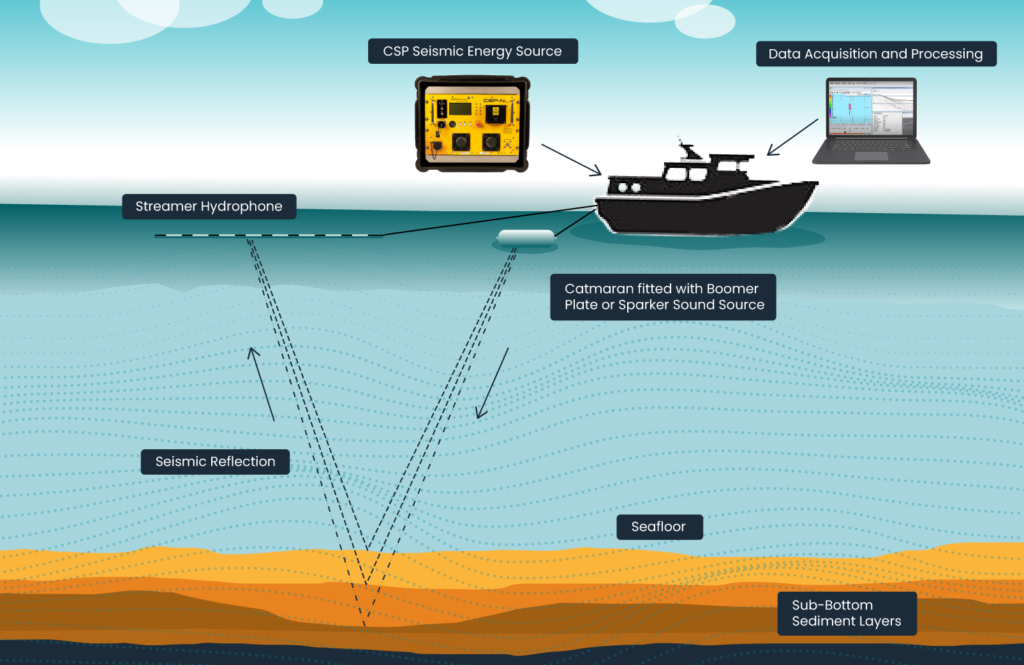Guide to Sub-Bottom Profiling

Whether you’re an energy company looking to survey an offshore wind farm construction site or a telecoms company identifying safe routes for new marine cable installations, sub-bottom profiling is an essential part of a project’s safe design and completion.
But what is sub-bottom profiling and how does it work?
What is Sub-Bottom Profiling?
Sub-Bottom Profiling systems essentially work in a similar way to sonar, radar and other reflective positioning systems. They utilise an acoustic or seismic energy source, to trigger a pressure wave which travels down through the water column and into the seabed. By recording the reflected returns of this sound using a pressure sensitive hydrophone array, it is possible to build a picture of the subsurface structure and geology beneath the seabed.
There are a variety of different sub-bottom profiling systems available, some transmitting very high frequencies capable of identifying small geological features in the shallow part of the seabed (less then 10m below seabed) and some transmitting lower frequencies capable of identifying deeper geology and features (large features at 100m or more).
[Note: although lower frequencies can identify deeper geology and features, there is a trade-off in ‘resolution’. High frequencies = high resolution, shallow imaging. Low frequencies = low resolution, deep imaging.]
Types of Sub-Bottom Profiler:
SBP sound sources come in four main types, each suited to different survey environments and survey objectives:
- Pinger — The highest-frequency system (operating between 2 and 20 kHz). Uses a ceramic transducer to produce and detect acoustic pulses. Produces a high-resolution image capable of resolving small features. However, it cannot penetrate very deep into the seabed (10s of meters, depending on sediment type and water depth).
- Chirp — Another high-frequency system used for high resolution, shallow penetration surveys (usually 20-50m depending on sediment type and water depth). Chirps produce a long (low frequency) pulse, made up of multiple higher frequency waveforms. This increases the overall energy that can be output by the source, improving penetration.
- Boomer — A lower-frequency system (dominant frequencies between 500 Hz and 5 kHz) capable of penetrating much further beneath the seafloor (up to 100m). Uses an induction coil and metal plate to produce acoustic pulse. Can use a single plate or a triple plate system. The combined energy output by the triple plate system is advantageous in deeper water survey settings (up to 1000m). Capable of producing high resolution data in the 10s of cm range (depending on sediment type and water depth)
- Sparker — works by producing an electrical spark, which vaporises the sea water around the tip of the sparker array. This vaporised water rapidly expands producing a pressure wave. Large very high-powered (~12,000kJ) sparkers can produce lower frequency (down to 50Hz) and penetrate down to 1000m. Smaller sparker systems are typically employed for high-resolution sub-bottom surveys have frequency ranges comparable to that of a boomer. These often achieve penetration in excess of 100m and resolution as good as 15cm (depending on geology and survey setting).
Note: Boomers and Sparkers are usually mounted and towed on their own catamaran with a hydrophone array towed separately.

Data uses:
The data recorded by sub-bottom profilers can be used for many different purposes, including:
- Geohazard assessment for drilling or construction projects
- Planning geotechnical surveys
- Cable route surveys
- Imaging subsurface structures, geo-model building
- Identifying corals and marine habitats
- Environmental monitoring and management
- Offshore aggregate mining/monitoring surveys
Sub-Bottom Profiling System?
Boomer and Sparker sub-bottom profiling systems consist of four main component parts:
- Source: generates the seismic pulse
- Source power supply: provides HV electrical power for source. A small unit portable unit housing a bank of capacitors, that can be rapidly discharged to the source.
- HV cable: linking source to power suppy
- Hydrophone: Single channel (SCS) or Multi-channel (MCS) streamer (hydrophone array), for detecting seismic reflections.
- Data acquisition and processing software: for digitally recording and processing seismic data detected by hydrophone. Used to remove background noise from data and produce 2D profiles and charts.
Sub-Bottom Profiling Range
Here at aae technologies, we provide a range of industry-leading sub-bottom profiling equipment.
Boomer Systems
- AA251 — The best choice for inshore surveys and sediment analysis from smaller vessels.
- AA301 — Offers greater penetration thanks to the lengthened pulse width, ideal for coastal or shallow water surveys.
- S-Boom — A high-power, high-resolution system that uses three plates to create a focused beam pattern. Best for deep water, deep penetration surveys.
Choose from our single-plate AA251 or AA301 boomer systems, or our high-power triple-plate S-Boom system.
Sparkers
We carry a range of Dura-Spark and Delta Sparker sound sources, depending on the needs of your project:
- Dura-Spark L80 — A very lightweight (32kg), low-maintenance sparker, with a stable and consistent pulse. Ideal of coastal surveys on smaller vessels.
- Dura-Spark L200 — Versatile light (47kg) 200tip sparker. Slightly larger than the L80, allowing for increased power output.
- Dura-Spark UHD 240/400 — A flexible system that can be used in water depths from 5 to 1000m, the 240/400 system is ideal for ultra-high-resolution surveys.
- Dura-Spark UHD 400+400 — A sparker system with two 400-tip decks capable of Flip–Flop and Delay-Fire modes
- Delta Sparker — The most powerful of our sparker systems, the Delta is well suited to deeper sub-bottom profiling including geohazard assessment and construction surveys.
Hydrophones
All our SBP systems use streamer hydrophones with a flexible range of elements (1, 8, 12, or 20) for medium and low-frequency use. Our hydrophones are filled with silicon oil for neutral buoyancy and come with a 50m tow leader, pre-amplifier, and standard connectors.
Looking for a Solution for Sub-Bottom Profiling?
Or advice on choosing the best system for your requirements? If you want to explore the field on a deeper level or chat with us about our sub-bottom profiling product range, please feel free to get in touch today and speak to one of our expert team.






